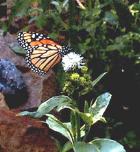 Spring Start
Spring StartBy Cyndie Thomas
Aurora, Colorado
Click images to enlarge
It is a sure sign Spring has made its return to the pond with the shimmer of sun on the water, lily pads striving to reach the surface, fish seemingly playing tag and birds making their regular visits several times a day.
Water gardening is less time intensive than many other types of gardening, but like all other types, maintenance is a must. Maintenance in spring (as early as you can stand the cold water) plays an important role in general pond health. Even the best-balanced ponds experience some alga until plants begin growth to provide shade and take up nutrients in the water. A little effort now can decrease water "greening" that may be unhealthy to pond life and just plain unsightly.
Inspect mechanical equipment such as pumps, cords, filters, and tubing for damage or wear: clean and replace as needed. Assess the condition of the liner or preformed pond for possible deterioration from sun or punctures. Check the electric circuit and make sure the GFI (ground fault interrupter) is working properly. If all is well, refilling the pond can commence. Water should be trickled in from the garden hose; this will decrease any rapid temperature change that could affect fish. A dechlorinator and chloramine remover should be used at the rate specified.
Check hardy marginal (bog) plants, trim away any remaining
dead foliage, divide and repot as needed. Heavy garden soil should
be used to pot all water plants. Potting soil, compost, vermiculite,
or perlite should not be used, as they float out and foul the
water.
Hardy lilies that have grown out of their pots should be repotted.
Remove dirt from the rhizome and roots by flushing with water.
Using a sharp knife on a hard surface, cut off any brown and
black roots and rotted (mushy) areas from the rhizome. Separate
side growth "eyes" from the primary rhizome for propagation.
Hardy lilies grow horizontally and should be placed against one
side of the pot at a forty-five-degree angle, with the growth
tip (crown) above the soil so it has room to grow across the
pot.
Fertilize marginal plants now and every 5-7 weeks through
the growing season. Lilies should also be fertilized now and
every 3-4 weeks, until early August. Tablet or pellet fertilizer
for aquatic plants is recommended. These products provide a slow
release of nutrients that plants can absorb. Plants can now be
returned to their growing spots in the pond
When pond refilling is completed, filtration and circulation
can be started. If a waterfall or stream is included in the circulation,
watch the pond water level for several days. If the water level
drops, it is likely that ground freezing and thawing has created
a problem that allows water leakage.
Tropical water plants can be placed in the pond when day temperatures near 70 degrees and night temperatures do not drop below 50 degrees, usually the middle of June.
Combining these procedures with an adequate balance of water plants will allow for your enjoyment of a healthy, beautiful pond for the growing season.




